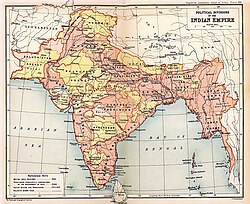Partition of India
The Partition of British India divided the British India into the countries of India and Pakistan (East and West Pakistan) in 1947. That was part of the end of British Raj, British rule in the Indian subcontinent. The prominent reason for partition was the two-nation theory, which was presented by Syed Ahmed Khan and stated that Muslims and Hindus were too different to be in one country. Pakistan first became became a secular Muslim-majority country and later an Islamic country. India became a majority Hindu country and later became a nominally secular country in 1974 when the word "secular" was added to the Preamble of the Indian Constitution.
Millions of people moved across the new Radcliffe Line between the two newly formed states. Once the lines had been established, about 14.5 million people crossed the borders to what they hoped was the safety of their religious majority. The 1951 Pakistani Census showed the number of displaced there were approximately 7,226,600. They were presumably Muslims who had entered Pakistan from India. Similarly, the 1951 Indian Census showed 7,295,870 displaced people, apparently Hindus and Sikhs who had moved to India from Pakistan. Both numbers add up to 14.5 million.
The newly formed governments were unable to deal with the forced migration of such huge numbers. Massive violence occurred on both sides of the new border.[1][2][3] Hundreds of thousands died; some estimates are in the millions.
The partition caused a lot of uncertainty in many parts of the new nations, especially in the region of Jammu and Kashmir, parts of which went to both countries, which went to war several times to try to take the whole region.
Further reading
- "If The British Had Never Ruled Our Country, This Would Be India Today". Souvik Ray. India Times. 30 July 2015.
Partition Of India Media
British Indian Empire in The Imperial Gazetteer of India, 1909. British India is shaded pink, the princely states yellow.
Indian medical orderlies attending to wounded soldiers with the Mesopotamian Expeditionary Force in Mesopotamia during World War I.
Mohandas Karamchand Gandhi (seated in the carriage, on the right, eyes downcast, with black flat-top hat) receives a big welcome in Karachi in 1916 after his return to India from South Africa.
Gandhi and Abdul Ghaffar Khan at a pro-independence rally in Peshawar, 1938
Jawaharlal Nehru, Sarojini Naidu, Khan Abdul Ghaffar Khan, and Maulana Azad at the 1940 Ramgarh session of the Congress in which Azad was elected president for the second time.
Chaudhari Khaliquzzaman (left) seconding the 1940 Lahore Resolution of the All-India Muslim League with Jinnah (right) presiding, and Liaquat Ali Khan centre.
Colonial India in 1947, before the partition, covering the territory of modern India, Pakistan and Bangladesh.
Video of refugees on train roof during the Partition of India
Refugees on train roof during partition
References
- ↑ D'Costa, Bina (2011). Nationbuilding, gender and war crimes in South Asia. Routledge. pp. 53. ISBN 9780415565660.
- ↑ Butalia, Urvashi (2000). The other side of silence: voices from the Partition of India. Duke University Press.
- ↑ Sikand, Yoginder (2004). Muslims in India Since 1947: Islamic perspectives on inter-faith relations. Routledge. pp. 5. ISBN 9781134378258.







